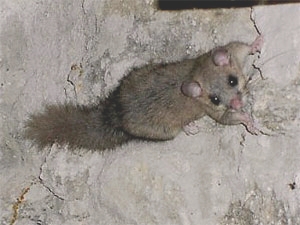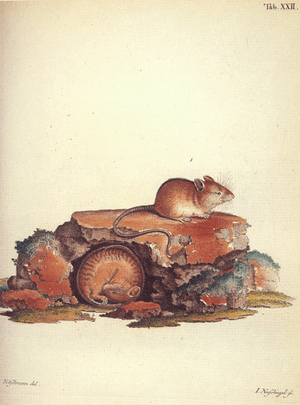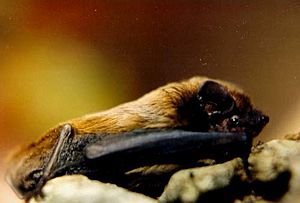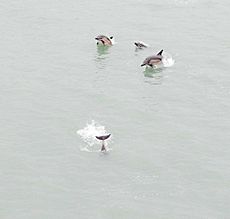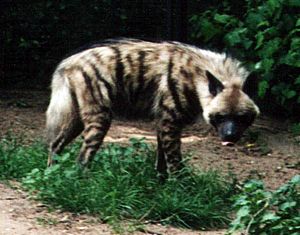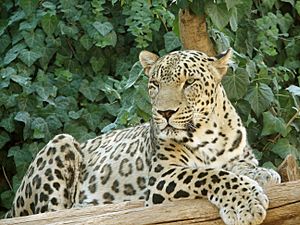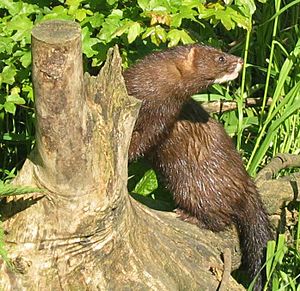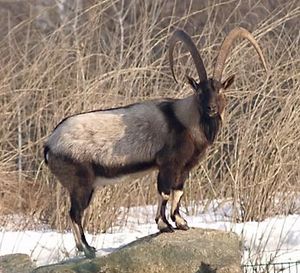List of mammals of Georgia (country) facts for kids
Georgia is home to 80 different kinds of mammals! These amazing animals are all placental mammals, meaning their babies grow inside their mothers with a special organ called a placenta. Sadly, some of these mammals are in danger. One species is critically endangered, two are endangered, ten are vulnerable, and two are almost threatened.
To help us understand how safe or at risk these animals are, scientists use a special system. Here's what the different levels mean:
| EX | Extinct | This means the animal is completely gone. There's no doubt the last one has died. |
| EW | Extinct in the wild | These animals only live in zoos or special protected areas, not in their natural homes. |
| CR | Critically endangered | This animal is in extreme danger of disappearing forever from the wild very soon. |
| EN | Endangered | This animal faces a very high risk of disappearing from the wild. |
| VU | Vulnerable | This animal is at a high risk of disappearing from the wild in the future. |
| NT | Near threatened | This animal isn't in immediate danger, but it might be in the future. |
| LC | Least concern | Scientists don't see any big risks to this animal right now. |
| DD | Data deficient | We don't have enough information to know if this animal is at risk or not. |
Contents
Order: Rodentia (Rodents)
Rodents are the biggest group of mammals, making up over 40% of all mammal species! They have two front teeth (incisors) in both their upper and lower jaws. These teeth never stop growing, so rodents have to keep gnawing on things to keep them short. Most rodents are small, but some, like the capybara, can be quite large.
- Family: Hystricidae (Old World porcupines)
- Indian porcupine, Hystrix indica
- Family: Sciuridae (Squirrels)
- Caucasian squirrel, Sciurus anomalus
- Caucasian mountain ground squirrel, Spermophilus musicus
- Little ground squirrel, Spermophilus pygmaeus
- Family: Gliridae (Dormice)
- Forest dormouse, Dryomys nitedula
- European edible dormouse, Glis glis
- Family: Dipodidae (Jerboas)
- Small five-toed jerboa, Allactaga elater
- Northern birch mouse, Sicista betulina
- Kazbeg birch mouse, Sicista kazbegica DD
- Family: Spalacidae
- Nehring's blind mole-rat, Nannospalax nehringi
- Family: Cricetidae (Hamsters and Voles)
- European hamster, Cricetus cricetus
- Turkish hamster, Mesocricetus brandti
- Caucasian snow vole, Chionomys gud
- Snow vole, Chionomys nivalis
- Robert's snow vole, Chionomys roberti
- Transcaucasian mole vole, Ellobius lutescens
- Altai vole, Microtus obscurus
- Long-clawed mole vole, Prometheomys schaposchnikowi
- Family: Muridae (Mice, Rats)
- Striped field mouse, Apodemus agrarius
- Yellow-breasted field mouse, Apodemus fulvipectus
- Broad-toothed field mouse, Apodemus mystacinus
- Black Sea field mouse, Apodemus ponticus
- Ural field mouse, Apodemus uralensis
- Eurasian harvest mouse, Micromys minutus
- Brown rat, Rattus norvegicus (This species was introduced by humans.)
Order: Lagomorpha (Lagomorphs)
Lagomorphs include hares and rabbits. They might look a bit like rodents, but they are actually a separate group of mammals. One key difference is that lagomorphs have four front teeth in their upper jaw, while rodents only have two.
- Family: Leporidae (Hares and Rabbits)
- European hare, Lepus europaeus
Order: Erinaceomorpha (Hedgehogs)
This group contains only one family, Erinaceidae, which includes hedgehogs. Hedgehogs are easy to spot because of their spiny coats!
- Family: Erinaceidae (Hedgehogs)
- Southern white-breasted hedgehog, Erinaceus concolor
Order: Soricomorpha (Shrews and Moles)
Soricomorpha are insect-eating mammals. Shrews look a lot like mice, but moles are strong diggers with chunky bodies.
- Family: Soricidae (Shrews)
- Bicolored shrew, Crocidura leucodon
- Lesser white-toothed shrew, Crocidura suaveolens
- Etruscan shrew, Suncus etruscus LC
- Transcaucasian water shrew, Neomys schelkovnikovi
- Eurasian pygmy shrew, Sorex minutus
- Radde's shrew, Sorex raddei
- Caucasian pygmy shrew, Sorex volnuchini
Order: Chiroptera (Bats)
Bats are unique because their front limbs have become wings, making them the only mammals that can truly fly! About 20% of all mammal species are bats.
- Family: Vespertilionidae (Evening Bats)
- Bechstein's bat, Myotis bechsteini
- Lesser mouse-eared bat, Myotis blythii
- Geoffroy's bat, Myotis emarginatus
- Natterer's bat, Myotis nattereri
- Western barbastelle, Barbastella barbastellus
- Asian barbastelle, Barbastella leucomelas LC
- Northern bat, Eptesicus nilssoni LC
- Savi's pipistrelle, Hypsugo savii
- Greater noctule bat, Nyctalus lasiopterus
- Lesser noctule, Nyctalus leisleri
- Kuhl's pipistrelle, Pipistrellus kuhlii LC
- Nathusius' pipistrelle, Pipistrellus nathusii
- Common pipistrelle, Pipistrellus pipistrellus LC
- Brown long-eared bat, Plecotus auritus
- Grey long-eared bat, Plecotus austriacus LC
- Common bent-wing bat, Miniopterus schreibersii
- Family: Rhinolophidae (Horseshoe Bats)
- Mediterranean horseshoe bat, Rhinolophus euryale
- Greater horseshoe bat, Rhinolophus ferrumequinum
- Lesser horseshoe bat, Rhinolophus hipposideros
- Mehely's horseshoe bat, Rhinolophus mehelyi
Order: Cetacea (Whales and Dolphins)
This group includes whales, dolphins, and porpoises. They are mammals that have fully adapted to living in water. They have sleek, almost hairless bodies, a thick layer of blubber for warmth, and their front limbs and tails are shaped to help them move through the water.
- Family: Balaenopteridae (Rorquals)
- Common minke whale, Balaenoptera acutorostrata LC (This whale is a rare visitor to Georgia's waters.)
- Family: Phocoenidae (Porpoises)
- Harbour porpoise, Phocoena phocoena VU
- Family: Delphinidae (Marine Dolphins)
- Short-beaked common dolphin, Delphinus delphis
- Common bottlenose dolphin, Tursiops truncatus DD
Order: Carnivora (Meat-Eaters)
There are over 260 species of carnivorans, and most of them eat meat as their main food. They have special skull shapes and teeth that help them hunt and eat their prey.
- Family: Felidae (Cats)
- Jungle cat, Felis chaus
- European wildcat, Felis silvestris (including the Caucasian wildcat)
- Eurasian lynx, Lynx lynx (including the Caucasian lynx)
- Leopard, Panthera pardus (This animal's presence in Georgia is uncertain.)
- Family: Hyaenidae (Hyenas)
- Striped hyena, Hyaena hyaena
- Family: Canidae (Dogs, Foxes)
- Golden jackal, Canis aureus (including the European jackal)
- Gray wolf, Canis lupus (including the Steppe wolf)
- Red fox, Vulpes vulpes
- Family: Ursidae (Bears)
- Brown bear, Ursus arctos
- Family: Procyonidae
- Common raccoon, Procyon lotor (This animal was introduced by humans.)
- Family: Mustelidae (Weasels, Otters, Badgers)
- Eurasian otter, Lutra lutra
- Beech marten, Martes foina
- European pine marten, Martes martes
- Caucasian badger, Meles canescens
- Stoat, Mustela erminea
- Steppe polecat, Mustela eversmannii
- Least weasel, Mustela nivalis
- Marbled polecat, Vormela peregusna
Order: Artiodactyla (Even-Toed Ungulates)
Even-toed ungulates are animals whose weight is carried equally by their third and fourth toes. This group includes many animals that are very important to humans, like cattle and sheep.
- Family: Bovidae (Cattle, Antelope, Sheep, Goats)
- Goitered gazelle, Gazella subgutturosa (This animal was reintroduced to Georgia.)
- Wild goat, Capra aegagrus
- West Caucasian tur, Capra caucasica
- East Caucasian tur, Capra cylindricornis
- Chamois, Rupicapra rupicapra
- Family: Cervidae (Deer)
- Family: Suidae (Pigs)
- Wild boar, Sus scrofa
Locally Extinct
The following animals used to live in Georgia but are now locally extinct (meaning they no longer live in Georgia, even if they still exist in other parts of the world):
- Asiatic cheetah, Acinonyx jubatus
- Moose, Alces alces
- Caucasian wisent, Bison bonanus
- Wild horse, Equus ferus
- Onager, Equus hemionus
- Mediterranean monk seal, Monachus monachus
- European mink, Mustela lutreola
- Northern lion, Panthera leo
- Caspian tiger, Panthera tigris
See also
- List of chordate orders
- Lists of mammals by region
- Mammal classification


